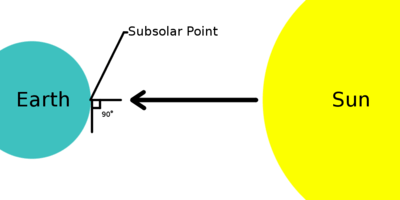Subsolar point
The subsolar point on a planet is the point at which its sun is perceived to be directly overhead (at the zenith);[1] that is, where the sun's rays strike the planet exactly perpendicular to its surface. It can also mean the point closest to the sun on an astronomical object, even though the sun might not be visible.

To an observer on a planet with an orientation and rotation similar to those of Earth, the subsolar point will appear to move westward, completing one circuit around the globe each day, approximately moving along the equator. However, it will also move north and south between the tropics over the course of a year, so it is spiraling like a helix.
The subsolar point contacts the Tropic of Cancer on the June solstice and the Tropic of Capricorn on the December solstice. The subsolar point crosses the Equator on the March and September equinoxes.
When the point passes through Hawaii, which is the only U.S. state in which this happens, the event is known as Lahaina Noon.[2]
References
- Ian Ridpath, ed. (1997). "subsolar point". A Dictionary of Astronomy. Oxford; New York: Oxford University Press. ISBN 0-19-211596-0.
The point on the Earth, or other body, at which the Sun is directly overhead at a particular time.
- Nancy Alima Ali (May 11, 2010). "Noon sun not directly overhead everywhere". Honolulu Star-Bulletin. Retrieved November 12, 2010.
External links
- Day and Night World Map (shows location of subsolar point for any user-specified time)